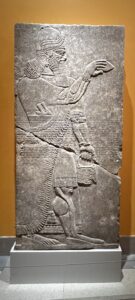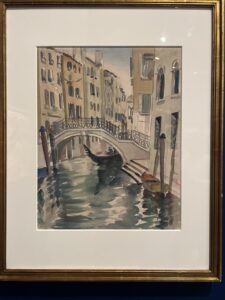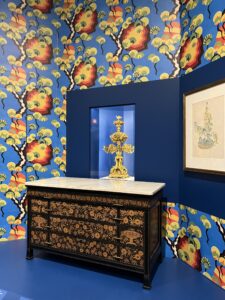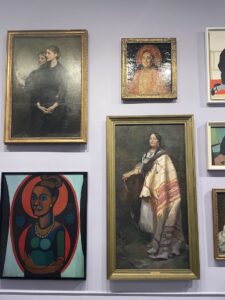I do not like rushing the art experience. This is because I think there is potentially a wealth of material to explore within a painting which can often take several minutes to uncover. Regrettably, I experienced the dissonance between this approach and that of my peers at the Night at the Brooklyn Museum.
The group assignment created a certain pressure to analyze a piece of art within a specific time frame. However, there was more than enough time to complete this task free of any stress. The reason I felt a time crunch in spite of the allotted time was because my fellow students wanted to move on to other paintings. I could understand their frustration. I do not think one needs to discuss all levels of depth of a painting, from visual to the conceptual, in order to extract value from it. The issue arose when my fellow attendees did not seem intrigued at the prospect of having an-in depth conversation about any of those points of investigation when it came to other paintings. Roblin Meeks might say they want to look at paintings, but not see them.
The lack of interest in meaningful engagement on the part of my classmates is quite an unfortunate circumstance because when we did discuss the painting for the group assignment, they shared insights I never would have considered.

The painting we focused on in the group assignment was Southern Landscape (Southern Flood) by Eldzier Cortor, which was made in 1944-1945. The story of this painting is that there has been a flood and the black couple have been neglected by their society as they are left bereft of everything while their town is swept away. Those I was working with pointed out that there are telephone poles in the water which also resemble crosses. I was able to build on this astute observation of theirs. I believe that the drowning of the crosses conveys that either the institutions of the religion have failed to produce equality for black Americans, or that society has allowed its prized religious ideals to be destroyed by its racial caste system. A connection which my classmates made that resonated with me is to the biblical splitting of the sea. The flood waters are depicted in the painting as the barrier between the now-destitute black Americans and intact houses. The painting essentially claims that one would have to split the sea in order to reach safety. This connection further supports the idea that there is a massive gulf which must be crossed between the racial discrimination which currently exists and the equitable state of being that one ought to strive for.
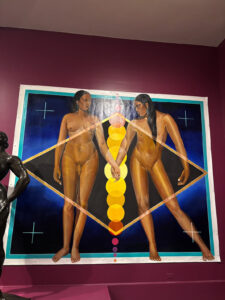
Once we moved on to other pieces like the one above, I was perturbed by the unwillingness of my classmates to attempt to gain a more sophisticated view of art. This piece is Four Genders Were Born… by Nanibah Chacon (2022). The artwork engendered bewilderment and amusement on the part of my classmates. I can completely understand their feelings. What I cannot understand is why they did not seek to understand the work on any kind of deeper level. It is true that the painting is highly provocative. It appears to show a serious misplacement of genitalia. My initial response to this artwork-much like my classmates-was one of shock and revulsion. I wanted to look away. This is because the subjects appear to possess a deformity. However, the deeper understanding I garnered from this painting is that genitalia does seem to lack the significance it is traditionally ascribed in determining one’s gender. I observe a clear male and female in this painting even though the genitalia has been swapped. The facial features and the remainder of the body produce this gendered effect. Consequently, what this painting communicates in the bigger picture is that gender is nuanced and contains a myriad of characteristics aside from genitalia. Gender may be strongly associated with genitalia. That is why the image feels wrong. However, in contrast to conventional wisdom, gender is far more complicated than what is under one’s pants or dress.
I eventually found a buddy with whom to explore the museum in some depth for the remainder of the time.
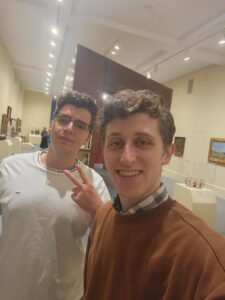

The above painting, Shifting the Gaze (2017) by Titus Kaphar, speaks to a common theme throughout the fifth floor collection: giving artistic expression to those whose voices are suppressed. This work merely involved painting white over the white figures in a Frans Hals painting. The purpose of this choice is to highlight the exclusion of those groups of people who were long neglected in art. I think this artistic decision is a grand idea. Every single individual deserves the opportunity to benefit from the value of art, which means that all groups should be included in the artistic conversation. The fifth floor contains a plethora of art made to tell the stories of indigenous people, minority women in prison and the black experience, among others. Telling these stories is essential because when people see subjects who look like themselves represented in art, they will feel included in the artistic dialogue and thus better able to benefit from any of the ideas fleshed out in the artwork. There was an entire section on the fifth floor dedicated to paintings of wealthy, white people who could afford to commission portraits of themselves. The purpose of including these is to demonstrate the contrast between the historical exclusivity which characterizes such commissioned art and the potential enriching impact that art can have if it emerges out of a wide range of backgrounds.
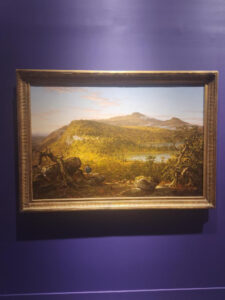
One painting which resonated with me was the above-A View of the Two Lakes and Mountain House, Catskills Mountains, Morning (1844) by Thomas Cole. This painting is powerful because of the small man looking out on this landscape in its bottom left. There is a beautiful depiction of greenery and towering mountains, but for me this is necessary but insufficient to evoke feelings of substantial agency. What provides the viewer vitality is the explorer who-stick in hand-is venturing out to the unknown to mark his acquisition of the territory. I was able to put myself in the explorer’s shoes and envision seeing this vast landscape before beginning an arduous hike.

Another painting which resonated with me was Sunset At Sea (1906) by Thomas Moran, which exhibits a glorious sunset over ocean waters. In a manner similar to the previous artwork, this painting does not alienate the viewer. The subtle way in which the image communicates agency is that there is a path shown to be seemingly open for travel through the turbulent waves. This is clear from the white reflection which flows through the valleys of the waves towards the middle of the painting. The viewer also feels as though he is being led to the sun, which is exhibited as the prominent source of power and energy. The sun blends into and almost seems to branch out into the clouds. The artist accomplishes this effect by coloring the clouds in various shades of orange depending on their distance from the sun. The viewer is made to feel like the sun has extended its influence over the other parts of the sky. Since the path through the ocean has been laid out towards this monumental celestial body, the painting further implies that it is reasonable for a person to aspire for the kind of vigor which the sun reflects on everything around it.

The final painting which appealed to me is Still Life with Fruit (1860) by Severin Roesen. Berger would dismiss this work as representing possession but I think he misses out on the value of the indulgence and luxury which is implied by such possession. The wine, the yellow grapes, and the sliced watermelons and lemons all convey exquisite pleasures and sublime affluence, even to a contemporary eye. In the case of sliced fruit, that is because one has the privilege of having food which is ready made to consume. At supermarkets today, sliced watermelon is more expensive than whole watermelon because of the additional value which the buyer receives from prepared food. Possession of such goods reflects possession of a highly desirable financial stability. My grandfather had a reputation for being a big-earner and big-spender and one of his sources of gratification was buying expensive fruit. He is who I think of when I view this image. My grandfather also loved to perform, which comes to mind in this image as well. There is the pleasure of the food and the wealth behind it which is conveyed, but there is even a performative aspect to one’s wealth, much like social media operates today. If a productive man two centuries ago wanted to show off his success, having a diversified fruit platter painted would certainly do so. I do not think there is anything wrong with material pleasure nor reveling in it. The viewer of this painting is given the opportunity to participate in not only the Dionysian lifestyle enabled by the security of massive wealth, but the pride which one can take in the pleasurable part of one’s existence.
In sum, I was able to benefit from the input and company of my classmates as well as the art itself even if the situation was not ideal.



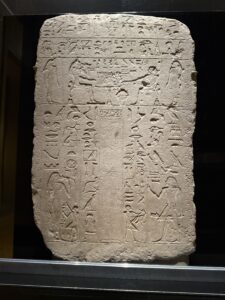

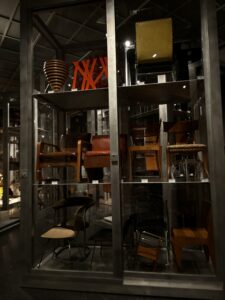




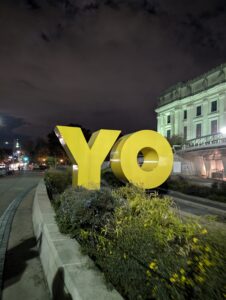








 We were then taken to the auditorium with all of the Macaulay kids from each campus, where I was able to learn a lot about art and culture. We then learned about the actual definition of a museum and artwork. When we were dismissed from the auditorium, we were free to explore the various exhibits on the different floors. I went straight to the fifth floor, which was notable for its confusing and interesting artworks.
We were then taken to the auditorium with all of the Macaulay kids from each campus, where I was able to learn a lot about art and culture. We then learned about the actual definition of a museum and artwork. When we were dismissed from the auditorium, we were free to explore the various exhibits on the different floors. I went straight to the fifth floor, which was notable for its confusing and interesting artworks.


